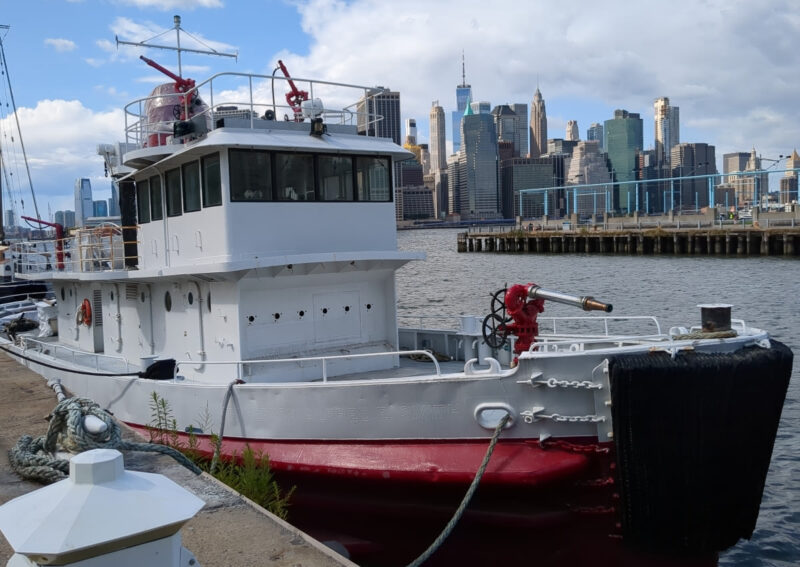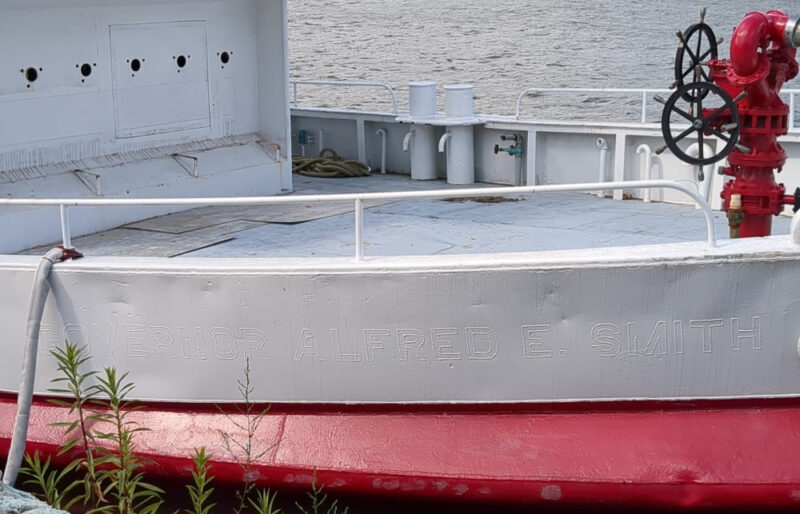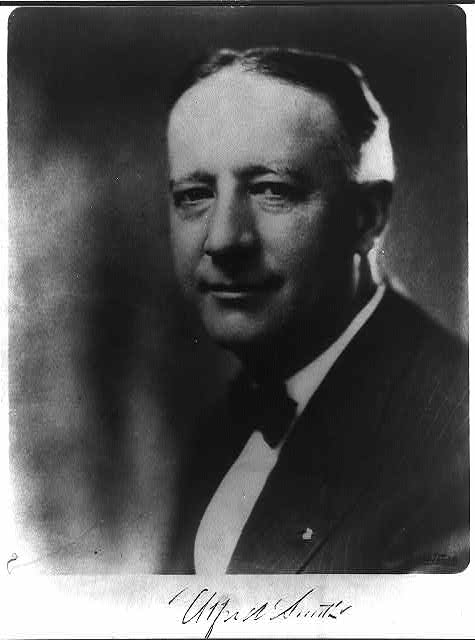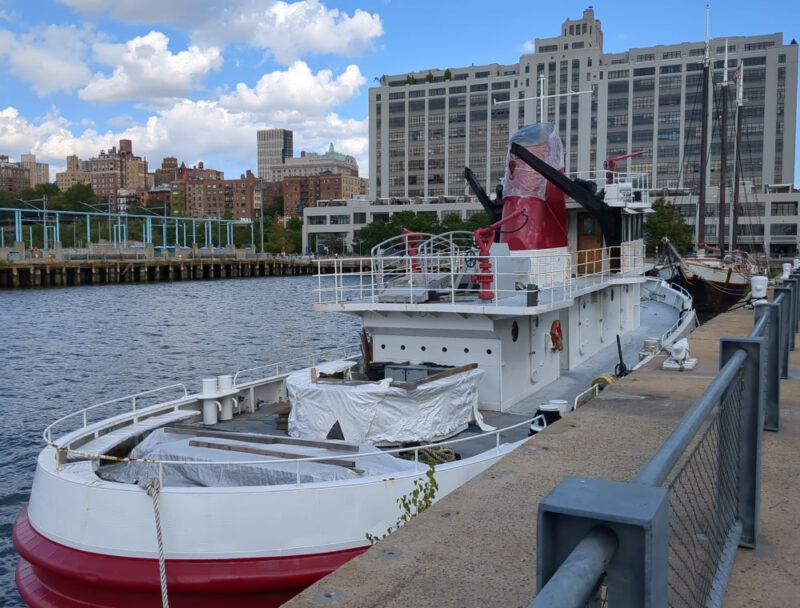I was walking through Brooklyn Bridge Park on the afternoon of August 21, 2024, taking all of the piers on the way. I once covered a sun-drying duck on Pier Five, which is adjacent to the Park’s Marina. For this article we go one pier down to Pier Six. While Pier Six does not have a marina, it did have three docked boats. One is a bar-on-boat which floats there for most of the year. But the other two boats were both very nice and unusual. For today’s post I will focus on one of the boats. The reason why I will focus on this boat has to do with the fact that the 2024 Democratic National Convention was ongoing on August 21, 2024. To be sure, the boat had little to do with the 2024 Convention, but the 2024 Convention made me think about its connection to the 1924 Democratic National Convention. How so? I invite you to take in my photograph of the starboard side of the nice boat.
You will see that the boat’s bulwarks have what appears to be a fresh coat of white paint and its name does not seem to appear. But if you squint, you should make out the boat’s painted over earlier name: “Governor Alfred E. Smith.”
Being a life-long resident of New York and something of an amateur presidential election historian, the name immediately arrested my attention. Al Smith is mainly known for two things. Firstly, he served as governor of New York in two separate stints, the first from 1919-20 and the second from 1923-28. Secondly, he became the first Roman Catholic to secure a major party nomination for president of the United States when the Democrats selected him on the first ballot at the National Convention. Of course, any good student of presidential history knows that the first Roman Catholic president was John F. Kennedy, pursuant to his narrowly winning the 1960 presidential election. Smith is relegated to something of a footnote in presidential election history because he lost in landslide fashion to Herbert Hoover in the 1928 general election. Smith sought a rematch in 1932 in what was a far more favorable electoral environment for the Democrats, but he lost out in a relatively brief convention to his successor as Governor of New York and former supporter, Franklin D. Roosevelt, who went on to just about flip the results of the 1928 election on Hoover in a fourth consecutive presidential election landslide.
Today our focus is not on 1928, however, but 1924. Smith stood as a candidate for the Democratic nomination at the 1924 Democratic National Convention at the old Madison Square Garden in Manhattan. He was seen as one of the most likely candidates for the nomination. However, the convention, which began on June 24, 2024, quickly turned into a stalemate, with Smith and his main rival, William Gibbs McAdoo, the former Secretary of the Treasury in the administration of his father-in-law, Woodrow Wilson, deadlocked at second and first respectively on ballot after ballot. One may think that it should have been easy to resolve the deadlock if two candidates stood far above the rest – but that was not the case. Two-thirds of the delegates were required to agree on a nominee, and neither McAdoo nor Smith every quite made it over half. The Democratic Party was beset by some issues peculiar to the era and its unwieldly coalition. Much of the 1924 commentary focuses on the internal party dispute over the role of the Ku Klux Klan, which unsurprisingly was less than enthusiastic about the prospect of a Roman Catholic nominee and generally favored McAdoo for the nomination. Smith’s core supporters were similarly and understandably less than enthusiastic about the Klan. Prohibition was also a dividing issue, with Smith opposed and McAdoo in favor. Those were significant factors, but in the end, this tire fire of a Convention defies any single simplistic explanation, bearing in mind that Smith would not only easily secured the nomination four years later, but saw five of his eight state wins in the general election come from the deep South, notwithstanding that was not the golden era for Roman Catholic politicians in the region (with the qualified exception of Louisiana, which was one of the eight states Smith carried).
From what I just told you, you may think that McAdoo found a way to scrape his way to the requisite delegates for the 1924 nomination. That was not the case. Smith and McAdoo finally gave up after the 99th ballot, paving the way for John W. Davis, who had become entrenched in a distant third place beginning with the 29th ballot. Having been stuck in New York by the stalemate for three weeks, the Democrats finally came together to put the dreadful affair out of their collective misery, nominating Davis on July 9, 2024, on the 103rd ballot, thereby ending the longest nominating convention in American history (note: the Convention had been briefly suspended on the account of the death of then-President Calvin Coolidge’s son). Davis, whose views in many respects were not highly distinguishable from those of the Republican nominee and popular incumbent president, New Leaf Journal regular Calvin Coolidge, and Davis lost in a landslide. He won just 12 states and 28.8% of the popular vote (a chunk of the non-Coolidge vote was taken up by third-party Progressive nominee Robert M. La Follette). Perhaps it is fitting that for all the angst of the Convention, there is no reason at all to believe that the identity of the Democratic nominee that year would have had a significant effect on the final results.
But I digress.
Coming back to the boat – I conducted some cursory research and learned that the Governor Alfred E. Smith is a fireboat that was built in 1961, 17 years after the death of its namesake, by the John H. Mathis Company’s shipyard (see a good source). The boat served with distinction in the FDNY’s fleet, not being placed in reserve until 2005. This article notes that the Alfred E. Smith saw firefighting service on 9/11 and “[t]he Smith’s crew was honored in 1967 for outstanding performance at the scene of the June 16, 1966 collision in Kill van Kull between the tankers Alva Cape and the Texaco Massachussetts.” Fortunately, the brave little fireboat was purchased by Crew in 2016 and restored to the pristine condition I saw it in at Brooklyn Bridge Park (I am not sure about it apparently being slated for restaurant duty, however). Still, I think the name of the boat ought to be colored in a way that stands out a bit more. Former Governor Smith, like the boat which bears his name, had more than enough of a career to be more legible. (Note: the boat also has a Wikipedia entry.)



